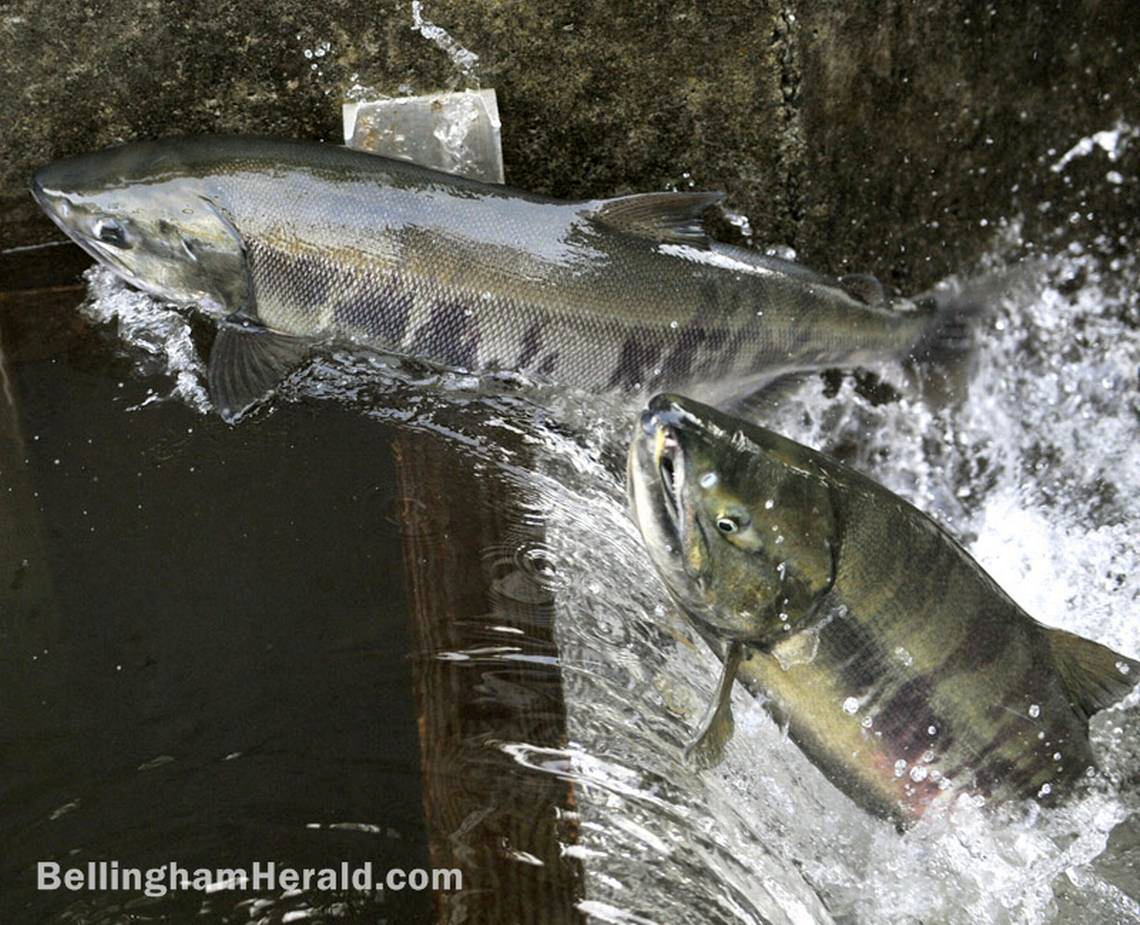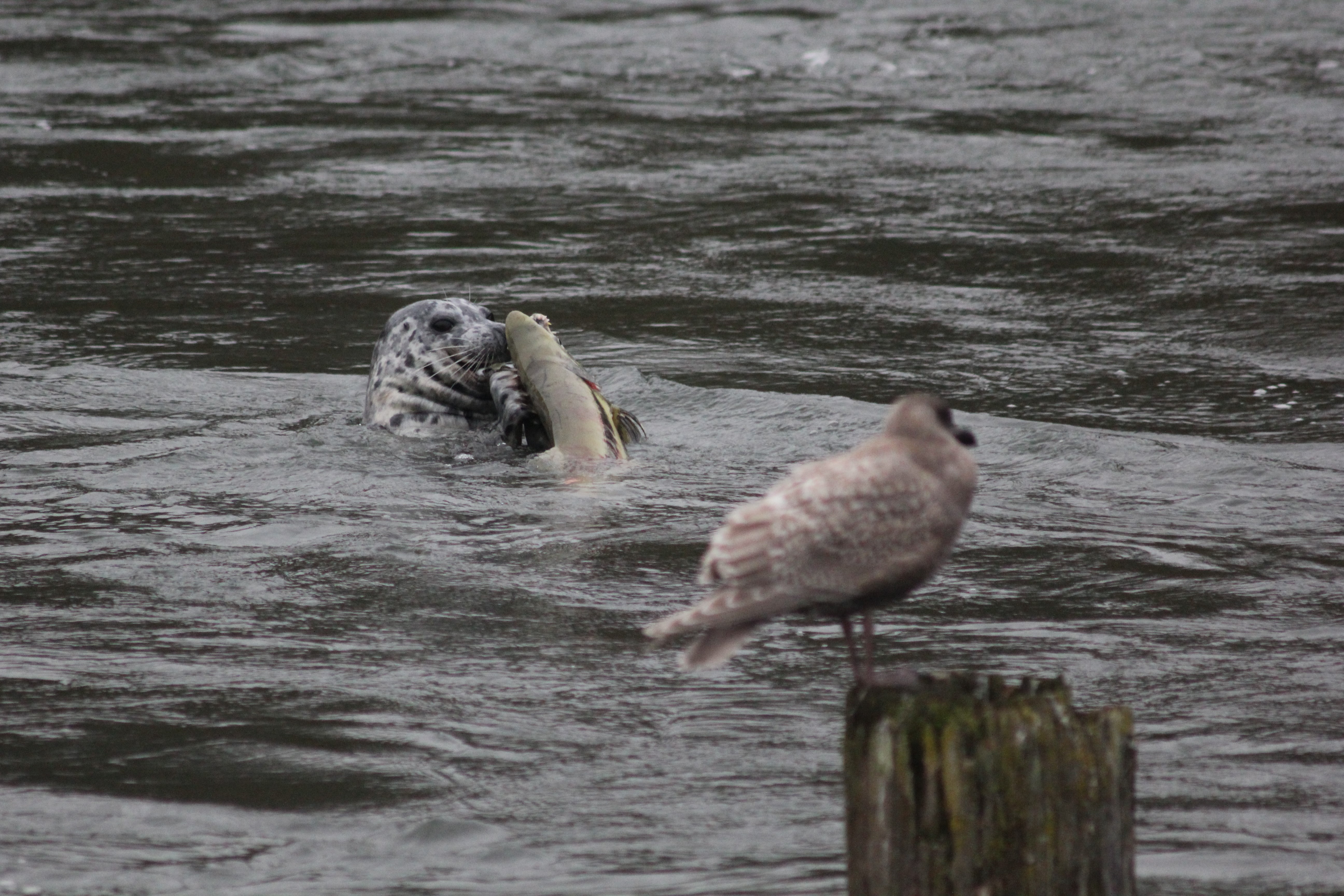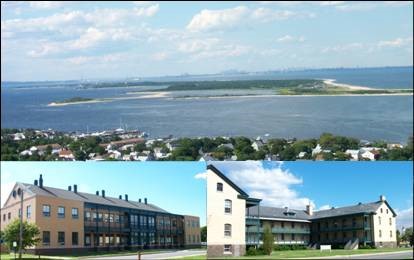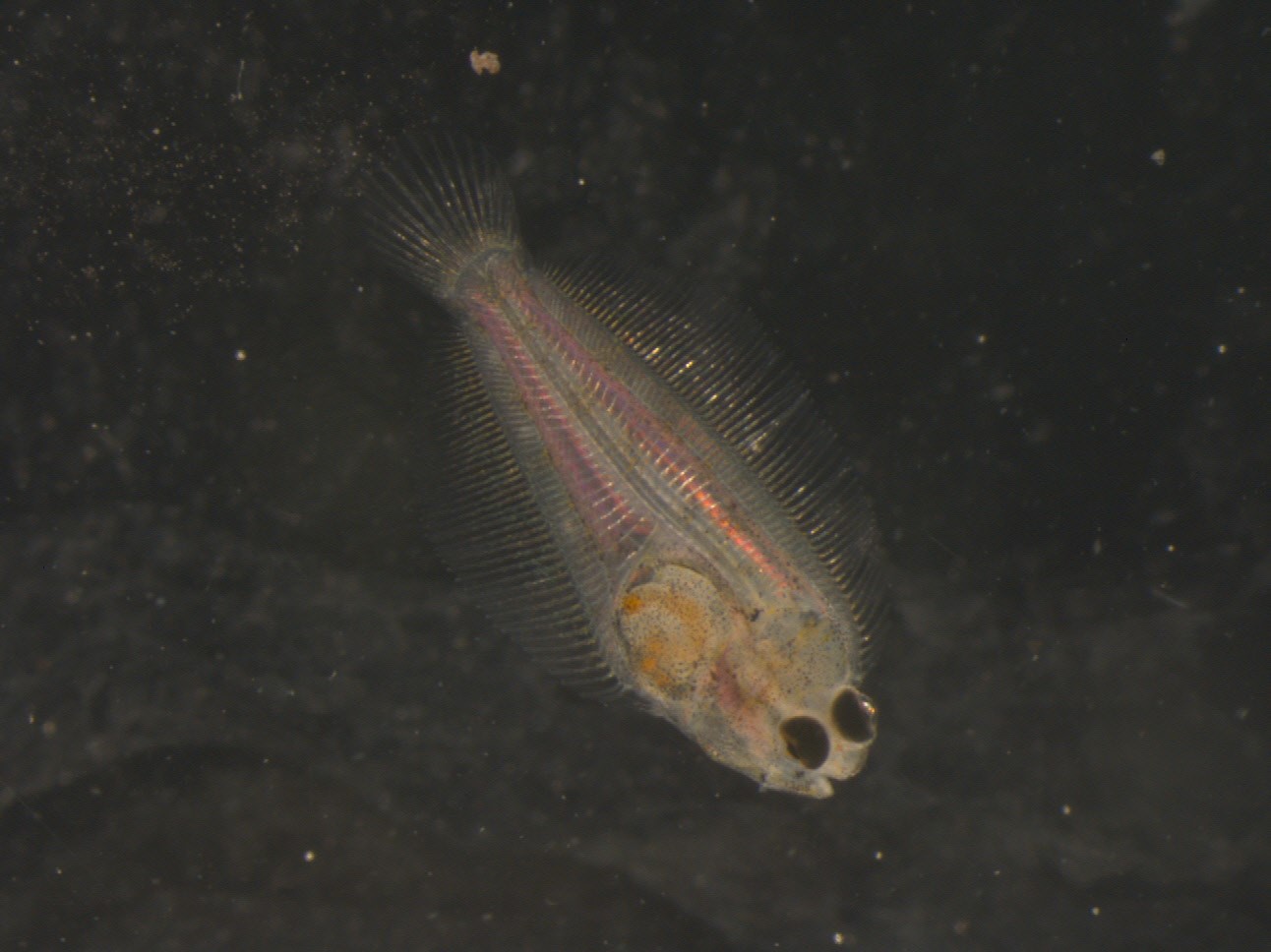September 2016
Hatchery and wild salmon
Rachel Wachtendonk, undergraduate student
30 September 2016
Fall has arrived which means we are getting into the busiest season for seals entering Whatcom Creek. The influx of seals ties closely with the annual salmon run. But it is not ordinary salmon that come to this creek; the salmon that run here are all hatchery salmon. The hatchery, which belongs to Bellingham Technical College, has been running since 1978. Apparently, the creek was not home to any wild salmon runs before the hatchery was introduced. We are unsure when the harbor seals first started taking advantage of the man made salmon run, but they continue to return to the creek every year.

Chum salmon on a ladder at the Whatcom Creek Hatchery. Photo: Bellingham Herald.
So why would the seals choose to forage hatchery salmon? Do these salmon populations differ from the wild salmon species found in the Salish Sea? Hatchery salmon tend to have reduced fitness compared to their wild counterparts if allowed to spawn on their own. To overcome this, many hatcheries including the one on Whatcom Creek catch adult salmon for artificial spawning. The offspring are released back into the system as smolts and when they return the cycle continues.
There is no natural run in Whatcom Creek so the wild salmon fry do not have competition in the streams but once the salmon reach the open sea they must compete with an abundance of hatchery salmon. There are other sources of competition between wild and hatchery salmon. Hatchery salmon may reduce the potential for wild salmon to spawn. Hybridizations of the two can reduce genetic variation and therefore lower the adaptive potential of the wild stocks. This can also effect the survival of hatchery fish. In the wild mating is selective and the fish with the best adaptive traits tend to have more offspring that carry those traits to the next generation. In hatchery salmon, the selection is artificial, which can lead to an accidental increase in frequency of poorly adapted traits.
While wild and hatchery salmon are different from each other, they have relatively the same nutritional value as far as the harbor seals are concerned. It is likely that one or a few seals discovered the hatchery as a new food source and now every year the seals have returned in greater numbers to take advantage of this new salmon run.

Harbor seal with hatchery salmon at Whatcom Creek. Photo: Skye French.
References:
- Bellingham Technical College website
- Berejikian, B.A., and M.J. Ford. 2004. Review of relative fitness of hatchery and natural salmon. U.S. Dept. Commer., NOAA Tech. Memo. NMFS- NWFSC-61, Seattle, USA. 28 pp.
- Grant, S.W. 2012. Understanding the adaptive consequences of hatchery-wild interactions in Alaska salmon. Environmental Biology of Fishes 94: 325-342.
Lab vs. field work
Raven Benko, undergraduate student
29 September 2016
An interesting decision that every undergraduate studying biology makes is whether to pursue research that is primarily laboratory-based, or to find a research project that allows you to gain experience in the field. In biology, unlike in other disciplines, the phrase “in the field” sometimes means literally doing research in a physical field. More generally, fieldwork means studying current systems out in the nature world – like what we do in the Marine Mammal Ecology Lab. For most budding scientists, a life of research out on a boat, climbing a mountain, or exploring the deep sea (just a few examples) sounds like a dream come true. And believe me, scientific fieldwork is exciting and thoroughly enjoyable. However it can also be tiring, wet, uncomfortable, and – lets face it – a lot of work. This summer I was able to join the “lab rats”, as they are often affectionately termed, and get a sense of what laboratory research is like. I hope this offers an interesting comparison for any of those struggling with these challenging decisions.
This summer, as part of my participation in the NOAA Hollings Scholarship program, I ventured to Sandy Hook, NJ to work in a section of the Northeast Fisheries Science Center at the J. J. Howard Marine Sciences Laboratory.

J.J. Howard Marine Science Laboratory. Photo Credit: NOAA Fisheries Service.
Here I studied under Dr. Christopher Chambers researching variance structures in behavior and hatch characteristics of larval to juvenile fish. This entailed 10-12 hours a day, usually 7 days a week (when dealing with live animals, someone has to be there to make sure they stay alive) of experimentation, wild specimen collection, spawning, observation, maintenance, and data collection. It was a whirlwind, so I’ll briefly go through the experiments that I was a part of and my overall thoughts of the experience.
- My first experiment stemmed from a question being studied by my lab partner Jacob Strock. He was trying to determine the affects of elevated temperature and dissolved CO2 (aka ocean acidification) on the prey consumption of recently metamorphosed winter flounder. My experiment involved determining the repeatability of prey consumption in these winter flounder. These little fish were about 8mm in length and were ready to eat brine shrimp – which we so dedicatedly counted out for them every trial by hand. I was hoping to determine the inherent variability in the system, but to go a little bit further we wanted to know: 1) how much prey does a recently metamorphosed winter flounder eat in a 6 hour period when fed in excess 2) if the same exact experiment is replicated, does the same fish eat the same amount each time 3) do all fish of the same category (one day post metamorphosis, reared in the same conditions) perform similarly or are some fish consistently better at catching prey than others? This information becomes important when we do start trying to understand the effects of environmental stressors so that we can better understand whether the fish are performing the way that they are because of their treatment or because the system is just inherently noisy. More so, we wanted to know if we repeated Jacob’s entire experiment again with the same fish would we get the same results or was the day-to-day behavioral variability too great to provide reliable information?
- My second experiment was concerned with ocean acidification and studied how prey consumption in winter flounder changed as individuals got older depending on which treatment they were reared in. This essentially allowed us to determine whether any affects that may have been seen at the 1 day post metamorphosis (dpm) stage were also exhibited at 10dpm, 20dpm, 30dpm, and 40dpm.
- The third experiment I was involved in looked at genetic and environmental affects on several hatch characteristics in Atlantic silverside. This involved a paternal half-sibling spawning design in which we strip-spawned one male with two different females at two different temperatures (replicated 2-10 times depending on the experiment). We then tracked the fertilized embryos through to hatching and collected all sorts of data like egg size, survival to hatch, size at hatch, persistence of yolk-sac larvae, and a few others. We are using this data to determine parental contribution to variation in all of these characteristics and the relationship that temperature plays – basically a genotype by environment response.

Recently Metamorphosed Winter Flounder.
All of this work sounds really cool, and it was, but what was life like in the lab day-to-day? I would roll in around 7am (after a 7-mile bike ride from my house) and ready the fish for experiments that day. Once all of the fish were in their feeding arenas, Jacob and I would count out brine shrimp for each fish in trials in quantities ranging from 8-700 by hand, sucking them up one by one with a pipette. This took sometimes several hours to complete. Then we would offer the prey to the fish, and set the clock for 6 hours. In that time I would prepare fish for the next day’s experiments, photograph them, individualize them, and then feed the stock fish that had left the experiment. Jacob and I would pull of any new metamorphs from the ocean acidification system, photograph, and individualize them. Then we would do whatever else needed to be done before our trials were up. This is often when I would help with spawning silverside, check our paternal-half sibling experiment for hatchlings, or help out in the lab any other way. There were usually 4 or 5 other experiments being run that could always use an extra hand. When our trials were up, we would remove the fish and return them to their holding containers and count off the remaining brine shrimp. When the work for the day was finally over (around 6 or 7pm) I would hop back on my bike or get a welcome ride home and collapse. Now, counting hundreds of brine shrimp a day doesn’t sound as glamorous as going in a deep sea submersible does it? But I honestly loved the work. I handled live animals daily, met so many people doing really interesting things in fisheries science, and got to formulate and systematically test out hypothesis.
Would I choose lab science over field science? It certainly isn’t any less work and can be mundane and tedious at times, just like lugging gear in oversized waders. But the best thing about laboratory science I found was being able to ask whatever questions I wanted and test them out (within reason). But I also enjoy being out in the elements with the ocean that I love. I don’t know if I can offer any better insight than it’s best try it out and see what you like for yourself!
Beginnings
Madelyn Voelker, undergraduate student
28 September 2016
This month has been very eventful with moving to Bellingham, starting school, and meeting all the other students. So far the toughest part has been re-teaching my body to sit in one spot for multiple hours at a time! With all this going on it has been challenging to carve out time for my thesis work. However, I feel like the ball is beginning to roll faster and that things are really getting started in regards to the next steps of my thesis.
One thing I have begun to focus on much more heavily this month is literature research. While not very glamorous, it will give me a foundation on which to build my research questions, methods of analysis, and interpretation of results (aka the whole project). This is a time-consuming process and one that doesn’t seem to have an end.
Another important beginning was getting a co-advisor. Dr. Dietmar Schwarz, who specializes in genetics, has agreed to be my co-advisor. This will be a huge help when I begin to sequence scat samples for individual DNA and sex. We have just started talking about this process. I will most likely jump into it full time during the winter quarter. I am also glad I will have his expertise when analyzing the results of the prey DNA analysis being done outside of Western.
One last beginning is of my taking on an undergraduate assistant. Brenna McClellan is going to be helping me process scat samples, among other things, this quarter. With around 400 samples to process this will be a big help. We hope to start processing the first week in October. We are going to aim to process 30 samples a week. If we succeed, we will have all the samples separated into a DNA-ethanol slurry (for prey DNA analysis) and prey hard parts (which will be identified to the lowest taxonomic level possible) by the end of the quarter. Both of these analysis will be done by someone outside of Western. Other news on this front, the scat freezer has migrated to the upstairs lab! It will be living next to the other freezer already in the lab from here on out. We were also able to have generator backed-up outlets installed for the freezer. So, if the power goes out we won’t have any scat-slush situations on our hands.
Although these first couple weeks have been very busy, I am excited about my new experiences. I am looking forward to the coming weeks and to getting to know the other members of the lab.
Best of luck to all for fall quarter!
Sincerely,
Madelyn Voelker
My introduction into biology research
Hannah Burley, undergraduate student
12 September 2016
To briefly introduce myself, my name is Hannah Burley and I am a senior undergraduate student at Western. I have always lived in Washington and grew up adventuring in the great outdoors that our state offers. It was through my adventuring that I fell in love with wildlife but I wasn’t always sure how I was going to integrate it into my life as more than just a hobby.
I started down the path towards becoming a biology major when I started at Western to see where it could take me. When I found out about research opportunities in the biology department I knew I had to get involved. I joined Alejandro’s lab in the spring of 2015 and have greatly enjoyed my time working both in the lab and out in the field.
The research we are doing is based in the Whatcom Creek estuary in downtown Bellingham. We have been studying the behaviors of the harbor seals that visit the creek and their interactions with the fish population. We are interested in any behaviors that we can observe which are mainly hunting, eating, social interactions between seals, and even inactivity of seals is noted. When seals surface the water we take photos of the front, left, and right sides of their face, as close up as we are able to. These photos are going to be used to identify individual seals by their spotted markings. We also collect data on where in the creek they surface, how long they are surfacing, and how many seals are up at a time. Then we note specifics about their behaviors that allow us to classify their actions. We are also taking note of the environmental conditions at the time of our observations, which can include weather and tide as well as people at the creek and other animals that are inhabiting the area.
All of our data that we are collecting, and have been collecting for the past several years, are being used to better understand the natural behaviors of our local seals. Understanding natural behaviors makes it much easier to pick out the individuals that may be having a big impact in the environment.